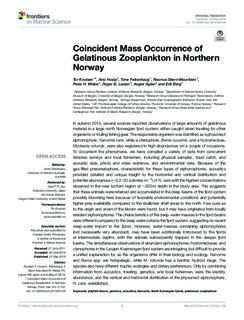| dc.description.abstract | In autumn 2015, several sources reported observations of large amounts of gelatinous material in a large north Norwegian fjord system, either caught when trawling for other organisms or fouling fishing gear. The responsible organism was identified as a physonect siphonophore, Nanomia cara, while a ctenophore, Beroe cucumis, and a hydromedusa, Modeeria rotunda, were also registered in high abundances on a couple of occasions. To document the phenomena, we have compiled a variety of data from concurrent fisheries surveys and local fishermen, including physical samples, trawl catch, and acoustic data, photo and video evidence, and environmental data. Because of the gas-filled pneumatophore, characteristic for these types of siphonophores, acoustics provided detailed and unique insight to the horizontal and vertical distribution and potential abundances (~0.2–20 colonies·m−3) of N. cara with the highest concentrations observed in the near bottom region at ~320 m depth in the study area. This suggests that these animals were retained and accumulated in the deep basins of the fjord system possibly blooming here because of favorable environmental conditions and potentially higher prey availability compared to the shallower shelf areas to the north. Few cues as to the origin and onset of the bloom were found, but it may have originated from locally resident siphonophores. The characteristics of the deep-water masses in the fjord basins were different compared to the deep water outside the fjord system, suggesting no recent deep-water import to the fjords. However, water-masses containing siphonophores (not necessarily very abundant), may have been additionally introduced to the fjords at intermediate depths, with the animals subsequently trapped in the deeper fjord basins. The simultaneous observations of abundant siphonophores, hydromedusae, and ctenophores in the Lyngen-Kvænangen fjord system are intriguing, but difficult to provide a unified explanation for, as the organisms differ in their biology and ecology. Nanomia and Beroe spp. are holopelagic, while M. rotunda has a benthic hydroid stage. The species also have different trophic ecologies and dietary preferences. Only by combining information from acoustics, trawling, genetics, and local fishermen, were the identity, abundance, and the vertical and horizontal distribution of the physonect siphonophore, N. cara, established. | |
